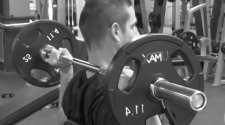Injuries with Behind the Neck Press

Proper Exercise Execution is Critical in Avoiding Injuries
The behind-the-neck press is a common exercise. In fact, everyone who picks up a weight tries it at some point. Some stick with it, and some don't, but generally speaking, those who drop it from their routines do so permanently. There are a number of reasons for that.
The main problem involves shoulder girdle flexibility-two components of the behind-the-neck press require more flexibility than the military, or front, press requires. The first is the starting position, where your shoulders are raised and externally rotated; that is, a position of full lateral rotation of the shoulders while they're abducted, It's the same whether you perform the exercise seated or standing-your upper arms are parallel to the floor as your forearms point straight up.
The second component that requires shoulder girdle flexibility is the ability to pull your shoulders back into a military posture, or scapular retraction, while maintaining the externally rotated position. If you can do those two things, then you have the necessary flexibility to perform behind-the-neck presses. If you don't, you should avoid the exercise. Otherwise, you invite injury and setbacks.
The problem is usually that the muscles that effect internal shoulder rotation, the agonists of the movement, are too tight. They include the pectoralis major, or pec; the teres major, or upper lat; latissimus dorsi, or at; and the subscapularis, which is part of the rotator cuff. While the anterior, or front, delt isn't one of the internal rotators, it, too, can prevent external rotation if it's too tight.
If you can't achieve full external rotation of the shoulders, then the external rotators of the rotator cuff-the infraspinatus and teres minor-must work too hard against the internal rotators in addition to supporting the shoulder joint during the pressing motion. Simply put, the external rotators can't overcome the excessive tightness and mass of the internal rotators. It causes too much strain. When you add the weight of the barbell, the muscles become overburdened and are subjected to a form of mechanical strain that produces injuries. Needless to say, that stress can cause shoulder pain stemming from a strain of the rotator cuff, the biceps tendon, the deltoid, the bursa (a fluid-filled sac that assists in protecting tendons from erosion) or the ligaments of the joint.
All that said, there's another problem that results from performing behind-the-neck presses when you have poor flexibility. Trainees who cannot achieve the necessary range of motion with their shoulders usually compensate by rounding their upper backs and lowering their necks to angle the neck and head forward. That gets the neck out of the way so the bar can travel behind it, but it also makes matters worse because the shoulder must try even harder to make the bar travel upward, and the neck drops to a less stable position. The upper trapezius, which is attached to the neck, works very hard when you do behind-the-neck presses, and the contraction of the trapezius produces significant force on your neck, especially if the neck isn't stable. Note that this neck strain can occur even if you have an adequate range of shoulder motion, but a poor range will add to it.
Another potential for injury occurs when trainees strain to get one more rep at the end of a set, and their necks strain excessively in the press position, as discussed above. The neck isn't an accessory muscle in this lift. The safest position is to hold it somewhat, but not completely, relaxed.
Excessive neck strain can damage one of the disks between the bony vertebrae in the neck, causing it to herniate, or protrude, and producing nerve damage. That can be a serious problem, the symptoms of which include pain radiating down the arm; numbness in the arm or hand; weakness of the shoulder, arm or hand muscles; and possible atrophy of certain muscles. I If you can do this exercise, another way to make it easier and a little safer is to start in the top position, using a power rack with the bar hooks- not the long pins-set high.